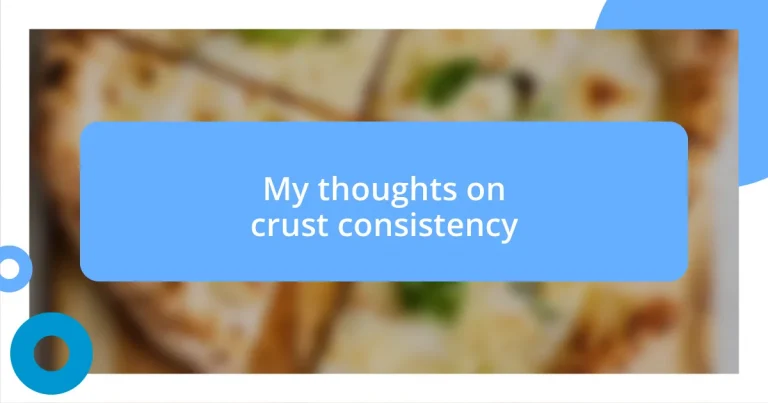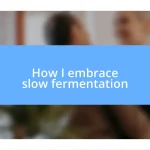Key takeaways:
- Crust consistency significantly influences the overall experience and enjoyment of baked goods, highlighting factors like texture and flavor balance.
- Key factors such as flour type, hydration level, and oven temperature are crucial for achieving the desired crust thickness and texture.
- Evaluation techniques, including visual, tactile, auditory, and taste assessments, are essential for ensuring a well-baked crust.

Understanding crust consistency
When I think about crust consistency, I can’t help but reflect on the incredible variety it encompasses. Consider the delightful crunch of a perfectly baked pizza crust—every bite should offer a satisfying snap, right? It pulls together this whole experience, enhancing the flavors of the toppings.
I remember the first time I experimented with making sourdough bread. The crust was a revelation—a deep, golden hue that enveloped a soft, airy interior. What struck me most was how the crust locked in moisture, creating this beautiful contrast with the chewy crumb. Isn’t it fascinating how just the right amount of humidity and temperature during baking can impact that crust?
When we talk about crust consistency, we should consider how it affects the overall dish. Have you ever bitten into a pie crust that was too soggy? That texture can drastically alter your enjoyment. Personally, I think a flaky, buttery crust is the perfect partner to a sweet filling, offering that textural harmony that makes each bite memorable.

Importance of crust texture
Crust texture is vital because it impacts not just the taste but also the overall experience of a dish. I still recall a family pizza night where the crust was disappointingly dense—every bite felt like a chore rather than a treat. The right texture should complement the toppings and provide that satisfying union of flavors.
- A crunchy crust can elevate the flavor of savory dishes.
- A flaky crust enhances the sweetness in pies.
- The right crust prevents sogginess and retains moisture, making every bite delightful.
- Texture can influence how ingredients interact, enriching the overall taste experience.
- A well-balanced crust invites you in, making you eager for the next bite.
It’s interesting how a crisp croissant, with its delicate layers, brings joy with each flaky morsel. Those little details matter deeply; it’s the element of surprise in each bite that keeps us coming back for more. I often find that a well-crafted crust holds memories, too—like baking bread with my grandmother, where the anticipation of the texture added to the love that filled our kitchen.

Factors affecting crust thickness
Understanding how various factors affect crust thickness can truly enhance our baking experience. From my perspective, one of the most significant influences is the type of flour used. For instance, using bread flour, which has a higher protein content, results in a thicker and sturdier crust, while all-purpose flour lends itself to a more delicate and tender outcome. It took me time to discover this, but now I know that choosing the right flour can set the stage for the ideal crust.
Another factor to consider is the hydration level of the dough. Higher hydration can lead to a thinner crust, as it creates steam during baking, making the dough spread out more. I still recall trying to make a Neapolitan pizza; my initial attempts resulted in a crust that was too thick and chewy. Once I adjusted the water-to-flour ratio and allowed the dough to rest properly, the transformation was remarkable—it turned crisp and light, just as I hoped.
Temperature also plays a crucial role. A hotter oven can achieve that perfect crust thickness quickly, often producing a lovely balance of chewiness and crunch. I remember when I first got my pizza stone. It felt like a game changer; the crust baked evenly, and every bite was a delight. It taught me that patience and the right environment are key to achieving that satisfying crust thickness.
| Factor | Description |
|---|---|
| Type of Flour | Affects protein content and texture; bread flour leads to thicker crusts. |
| Hydration Level | Higher ratios create steam, resulting in thinner crusts. |
| Oven Temperature | A hotter oven leads to quicker baking, improving thickness and texture. |
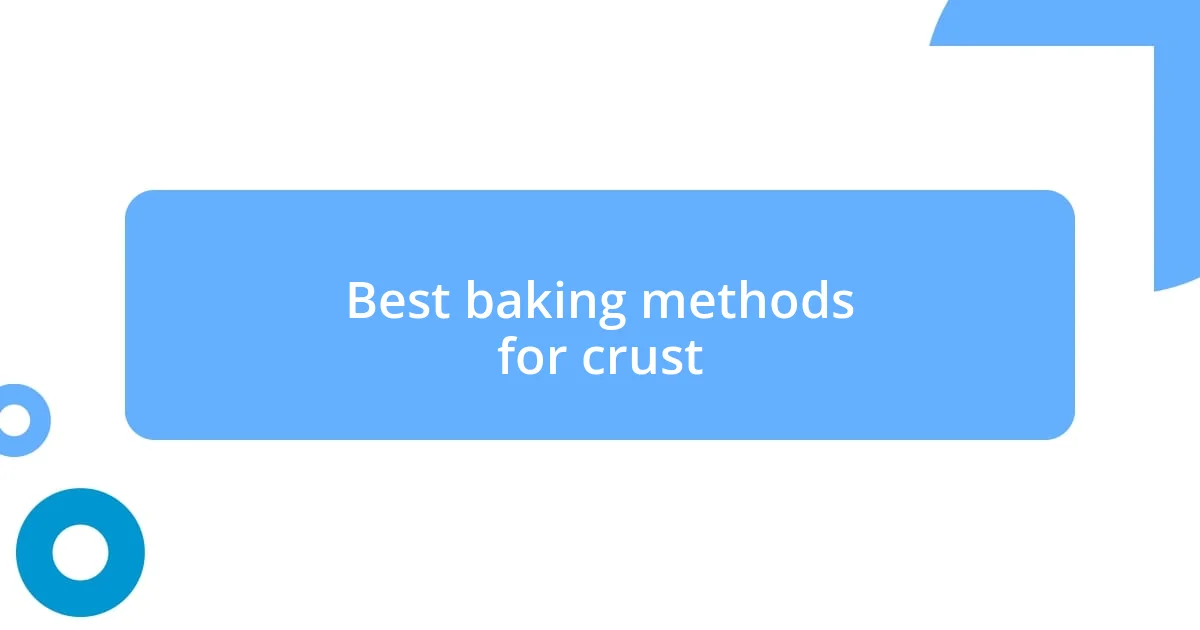
Best baking methods for crust
When it comes to baking methods that yield the best crust, one technique I’ve come to appreciate is preheating my baking surface. Using a pizza stone or a cast iron skillet can significantly enhance the crust’s texture. I remember the first time I placed my dough on a preheated stone; the immediate sizzle was music to my ears. It created a beautiful, crusty bottom that I’ve often tried to replicate since.
Another method I swear by is using steam in the oven, particularly for bread. It may sound a bit quirky, but adding a pan of water to the bottom of the oven while baking can make a world of difference. This creates steam, helping develop a crust that’s both crunchy on the outside yet tender on the inside. The first time I saw the transformation of my bread, it felt magical—seeing that crispy outer layer form while the inside remained soft was incredibly rewarding.
Lastly, the role of baking time cannot be understated. Experimenting with slight variations has opened my eyes to the importance of finding that sweet spot. It’s easy to get distracted and overbake, which can turn a promising crust into a disappointing one. I recall an instance where I misjudged the timing on a pie, thinking a darker crust would be best. What I ended up with was a burned edge that overshadowed the delicious filling. Trust me, keeping an eye on your bake is crucial—it’s about finding joy in the moment as your crust comes to life!
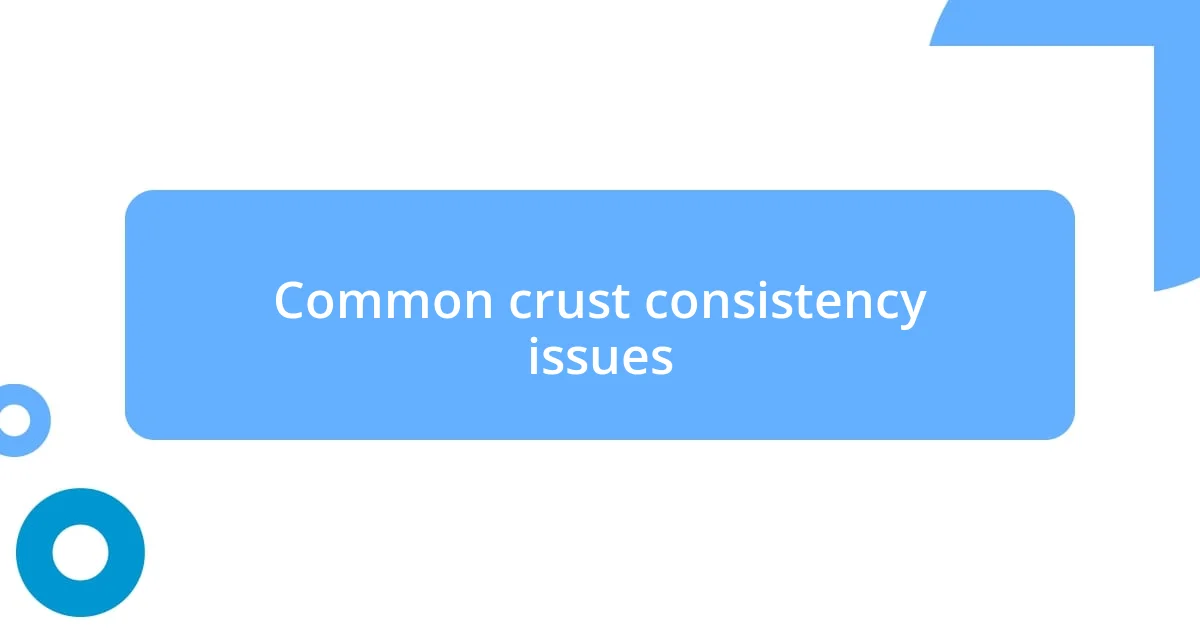
Common crust consistency issues
We often encounter issues with crust consistency during baking, and over- or under-kneading the dough is a common culprit. I’ve had my share of disappointing moments when I got too eager with my mixer, ending up with a crust that was dense instead of airy. It’s fascinating how a little patience and care in kneading can make a world of difference; allowing the gluten to develop properly transforms the finished product into something truly delightful.
Another frequent problem is related to temperature control, which can directly affect the crust’s texture. I’ve learned this the hard way! During one ambitious baking session, I mistakenly opened the oven door too often to peek—my crust ended up flabby and unappetizing. Keeping that oven door closed allows the heat to do its magic, creating a more evenly baked, appealing crust.
Lastly, improper proofing can lead to inconsistent crusts as well. I can recall a time when I rushed the proofing stage because I was excited to eat fresh bread. The result? A crust that was tough and chewy instead of the delightful golden-crisp I envisioned. Allowing dough to proof adequately helps develop the flavors and textures we crave. Isn’t it amazing how the simplest adjustments can yield such significant results?

Tips for achieving perfect crust
When aiming for the perfect crust, always remember the importance of chilling your dough. I can’t tell you how many times I rushed this step, excited to bake right away. However, letting the dough rest in the fridge not only helps with easier rolling but also leads to a more flavorful crust. There’s something incredibly satisfying about biting into a flaky, tender crust knowing that a bit of patience made all the difference.
Another tip that has changed my crust game is using the right flour. I once tried a low-protein flour out of curiosity, but my results were disappointing. High-protein flours, like bread flour, give that much-needed structure and chewiness to the crust. It’s amazing how something as simple as the type of flour can elevate a dish from mediocre to absolutely memorable.
Don’t forget to embrace a generous coating of egg wash before baking. I remember my first experience with this simple technique; the golden sheen that developed was like a surprise gift. Not only does it enhance the appearance, but it also contributes to that delightful texture we all crave. Have you ever gotten that beautifully shiny, crisp finish? If you haven’t tried it yet, you might just be missing out on a crucial step for the perfect crust!
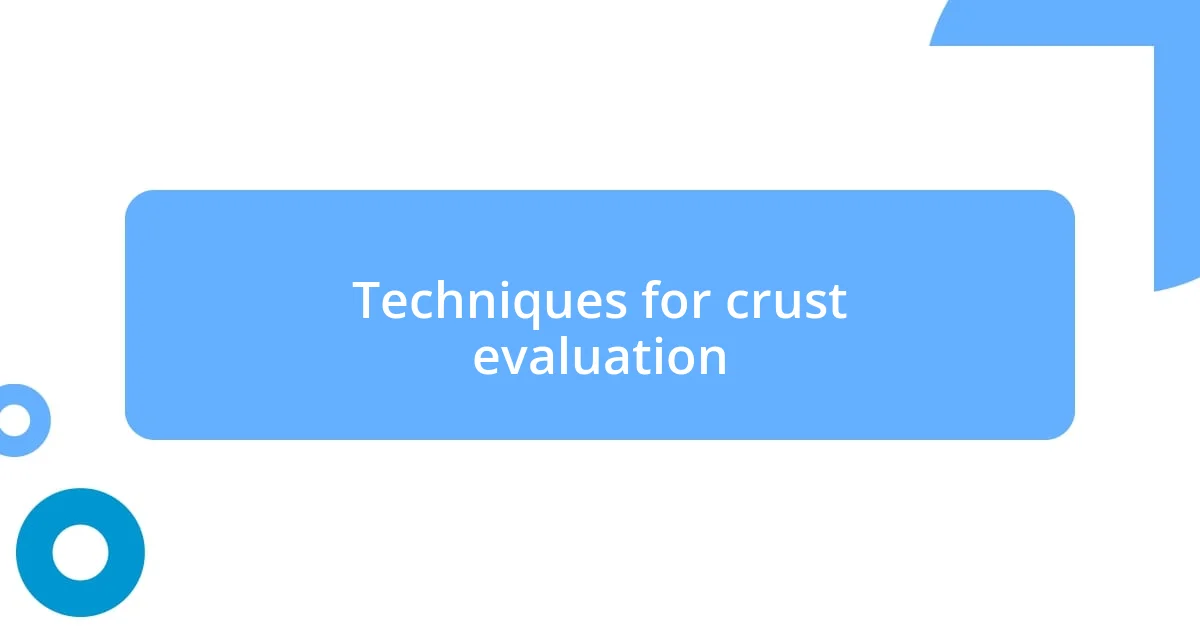
Techniques for crust evaluation
To effectively evaluate the crust’s consistency, I frequently rely on both visual and tactile assessments. I’ll often observe the color; a lovely golden-brown hue is a clear indicator of a well-baked crust. When I touch it, I look for a crisp texture—if it feels soft or spongy, I know something has gone awry. Isn’t it fascinating how much information you can gather just by engaging with your food?
Another approach I find helpful is to listen to the crust. Seriously! When I knock on it lightly, a hollow sound suggests a light and airy interior. If it sounds dense, I usually prepare myself for disappointment. This auditory cue is something I wish I’d paid more attention to in my earlier baking attempts—it could have saved me from those less-than-stellar crusts!
Finally, I can’t stress enough the impact of taste testing for evaluation. I’ve taken a slice of bread right out of the oven more times than I’d like to admit, eager to experience that first bite. The flavor can reveal a lot about the crust’s consistency; if it’s bland or gummy, it often indicates issues in the baking process. How often do we rush the important steps, only to end up with disappointing results? Taking the time to assess all aspects truly transforms the baking experience and outcomes!












